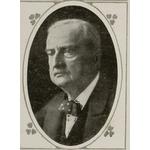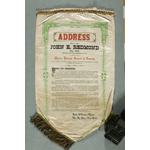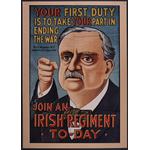Those that set the stage
John Redmond and the Irish Parliamentary Party
To some extent Redmond contributed indirectly to the Rising by failing to secure an acceptable degree of Home Rule; his main contribution, however, was in discouraging Birrell and Nathan from taking action against those planning the Rising.
John E. Redmond (1856-1918), son of William Redmond, nationalist MP for Co. Wexford, was educated by the Jesuits at Clongowes Wood College, Co. Kildare and at Trinity College, Dublin. First elected as an MP in 1881, he represented Waterford from 1891 until his death.
Following the split in the nationalist Irish Parliamentary Party arising from Parnell’s involvement in a divorce case, he led the Parnellite wing from 1891, becoming leader of the reunited Party in 1900.
Having strongly supported Gladstone’s Home Rule bills of 1886 and 1893, the achievement of Home Rule was his life’s goal, his best opportunity arising when the IPP held the balance of power under Asquith in the period from 1910 onwards.
Opposition by the Ulster Unionists frustrated his plans, his main worry being that Home Rule would result in the permanent exclusion of at least some of the Ulster counties, that is the partitioning of the country.
He also feared that the activities of the Irish Volunteers might hinder the enactment of Home Rule; to guard against this eventuality he secured the control of the organisation in June 1914. He welcomed the Government of Ireland Act, 1914 as the only measure of Home Rule then possible; its suspension for the duration of the war postponed addressing the issue of partition.
To ensure the success of the war effort and the more speedy implementation of Home Rule, Redmond offered the services of the Irish Volunteers for the defence of the country, an offer rejected by the government.
By encouraging the Volunteers to join the British army, he split the organisation; the vast majority, totalling 170,000 and thereafter known as the National Volunteers, followed Redmond, many of them enlisting in the British army.
Those who aspired to an Irish republic or who had simply lost faith in Home Rule remained as the Irish Volunteers, their numbers now reduced to about 10,000. Redmond had lived in England for many years and was out of touch with developments at home. Consequently, the 1916 Rising took him completely by surprise.
Committed to keeping Ireland within the Union, he regarded the Rising as treason and a ‘German intrigue’. He had no sympathy with the leaders or their objective of a republic. Nevertheless, he pleaded for leniency in the House of Commons.
Redmond was dead within two years of the Rising, not yet fully aware that history had moved on, and that the Holy Grail of Home Rule would no longer satisfy the up-coming generation of Irish nationalists.







